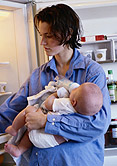
TUESDAY, Feb. 7 (HealthDay News) — Despite earlier research that suggested the rotavirus vaccine increased the risk of intussusception — when a portion of the intestine slides forward into itself — a large new study finds this is not the case.
“The findings of our study are reassuring and add to the evidence that the benefits of rotavirus vaccine, in terms of reducing doctor’s visits hospitalizations and deaths from rotavirus disease, is far greater than any low-level risk for intussusception that may exist,” said lead researcher Irene Shui, a postdoctoral fellow at Harvard Medical School and Harvard Pilgrim Health Care Institute in Boston.
In 1999, the first rotavirus vaccine was taken off the U.S. market due to increased risk of intussusception. But the U.S. Food and Drug Administration has since approved two new vaccines to prevent the infection — Rota Teq in 2006, and Rotarix in 2008.
Before the introduction of rotavirus vaccine, rotavirus disease occurred in the majority of young children, causing a substantial public health burden from severe cases of diarrhea, Shui said.
“Since its introduction, health care utilization for diarrhea has decreased dramatically and more than 50,000 hospitalizations a year in the United States due to rotavirus have been prevented,” she said.
The study appears in the Feb. 8 issue of the Journal of the American Medical Association.
For the study, Shui’s team looked at the risk of intussusception from the vaccine, focusing on the first week after the first dose of the vaccine was given.
Included in the study were infants aged 4 weeks to 34 weeks who were given the vaccine between May 2006 and February 2010. In all, this included almost 800,000 doses of the vaccine.
The researchers found no statistically significant increased risks for intussusception in either the month or week after the vaccine was given.
In the month following vaccination, there were 21 cases of intussusception compared with 20.9 expected cases. For the week following vaccination, there were four cases compared with 4.3 expected cases, the researchers found.
That works out to a risk of one case of intussusception for every 65,287 vaccine doses. The risk might even be lower, the researchers added.
Recent reports from international studies in Mexico and Australia found some evidence for a low-level risk, especially in the week following the first dose of vaccine, Shui said.
That’s because intussusception is rare and cases may be due to chance and not the vaccine, or due to genetic variations in populations where the vaccine was tested, the researchers noted.
“Given the rarity of intussusception, we cannot rule out that a small excess risk may exist following vaccination; however, this potential low-level risk is far smaller than the overall benefits from the vaccine,” Shui said.
Intussusception is a serious condition in which one part of the large or small intestine slides into another part, which can block food or fluid from passing through. Intussusception also cuts off the blood supply to the part of the intestine that’s affected. However, with prompt detection and treatment, almost all patients recover, Shui said.
Commenting on the study, Dr. Jeffrey Brosco, a professor of clinical pediatrics at the University of Miami Miller School of Medicine, said that “it confirms what we already know. The benefits of the rotavirus vaccine far outweigh the risks.”
The vaccine drastically reduces rotavirus infections that cause vomiting and diarrhea, he said. “It prevented about 55,000 hospitalizations in the United States in 2008 alone.”
Outside the United States, it’s even more important, Brosco said. “Here kids get hospitalized and get better, but across the world it’s one of the leading causes of death for infants,” he noted.
Children should get three doses of this oral vaccine at 2, 4 and 6 months of age, Brosco said. “It’s very safe and effective, and parents needn’t worry,” he added.
The study was supported in part by the Vaccine Safety Datalink contract with American Health Insurance Plans, funded by the U.S. Centers for Disease Control and Prevention.
More information
For more information on rotavirus, visit the U.S. Centers for Disease Control and Prevention.

